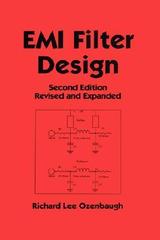
EMI Filter Design, 2nd ed.
Richard Lee (OZ) Ozenbaugh
(2000) 350 pages
READERSHIP: Electrical and electronics, power supply design, systems, and radio and telecommunications engineers, and upper-level undergraduate and graduate students in these disciplines.
reveals up-to-date insights into the cause and eliminaton of common mode noise in lines and equipment; covers resistive, transformer, switcher, and UPS load; examines lossey components and ratiated emissions; discusses benefits and limitations of Pl, T, L, dissipative, cauer, commercial, and conventional filters; compares and contrasts 50 and 60 Hz filters with 400 Hz; gives matrix transfer functions for various filters; details capacitor specifications, construction, and self-resonant frequency; summarizes isolation, leakage current, skin effect, and voltage translation; explores new data on spike, pulse, trapezoid, and quasisquare waves; evaluates the input and output impedance for differential mode and DC filters; reviews the latest high-current filters
Contents
Why call EMI filters black magic; Common and differential mode—definition, cause, and elimination; EMI filter source impedance of various power lines; Various AC load impedances; DC circuit—load and source; Typical EMI filters—pros and cons; Filter components—the capacitor; Filter components—the inductor; Common mode components; Transformer's addition to the filter; Electromagnetic pulse and voltage transients; What will compromise the filter?; Waves as noise sources; Study of the off-line regulator; Initial filter design requirements; Matrices—review of A matrices; Filter design technique; Matrix applications; Applications using round or square conducting rods; Packagine information; Design examples; Questionable designs; Review of filter design
Contact us at info@electrostatic.com
 Electrostatic Applications
Electrostatic Applications